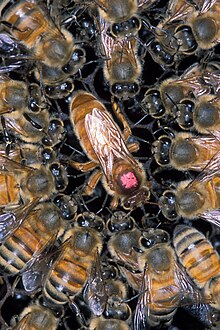Biological population
Biological population is a group of organisms or individuals of the same species that coexist in the same space and time, and that share certain biological properties, which produce a high reproductive and ecological cohesion of the group.
In biology, a special meaning of population, used in genetics and evolution, is to refer to a reproductive group whose individuals interbreed only with each other, even though it would be biologically possible for them to reproduce with all as well. other members of the species or subspecies. The main causes for which populations are delimited are physical isolation and behavioral differences.
The so-called population biology can be defined as that discipline whose object is the analysis of populations in terms of their biological attributes and the interactions between their members and with the surrounding environment.
In ecology, a set of local populations partially isolated from each other is called a metapopulation.
Sometimes the concept of a biological population is referred to by the terms "demo" or "give me" (from the Greek δεμοσ -"town"). See also clina.
Population types
According to the relationships that can occur between the individuals that make up the populations, they can be classified into several types.
Family Populations
They are those in which the union between the individuals that compose it is given by the relationship between them. in other words they are all family example: Pack of lions.
Gregarious Populations
They are those formed by passive transport or by the mobilization of individuals not necessarily related to each other. Examples of this are schools of fish (sardines, tuna), flocks of migratory birds (Canadian geese, swallows), herds of mammals (reindeer, wildebeest) and insects (locusts, monarch butterflies).
This link is not always permanent and occurs for a single purpose, such as migration, mutual defense or the search for food.
State Populations
They are those that are characterized by the division and specialization of labor among their members and that makes life impossible for them in isolation. Examples of this are social insects such as bees, termites and ants, etc.
Colonial populations
It is that grouping of individuals from a primitive one, to which it is normally attached. Examples of this are jellyfish and corals.
Characteristics of populations
There are certain attributes of organisms in their organization in populations, which do not occur in each of the isolated individuals. These characteristics or properties make it possible to define the different populations.
Biotic Potential
Refers to the maximum capacity that individuals in a population have to reproduce under optimal conditions. This factor is inherent to the species and represents the maximum reproductive capacity of females with optimal resource availability.
Environmental resistance
Refers to the set of factors that prevent a population from reaching its biotic potential. These factors can be both biotic and abiotic and regulate the reproductive capacity of a population in a limiting manner. These factors can represent both resources (such as water, shelter, food) and interaction with other populations (see ecological niche).
Growth Patterns
Refers to the type of graph that represents the growth rate of a population. Thus, we can find curves with sigmoid, exponential or decreasing growth, determined both by the biotic potential in its interaction with environmental resistance, and by the carrying capacity, which represents the average number of individuals that coexist when the growth curve is in the equilibrium phase. Carrying capacity is also defined as the maximum number of individuals that a given environment can support. The development of this curve has different stages, being represented in number of individuals per unit of time and, with respect to the characteristic biological cycles of each species, different stages, namely:
- slow phase or long phase
- logarithmic or logistic phase
- stable or balanced phase
Birth and death rates
These rates are determined both by the species (specific characteristic) and by environmental conditions (environmental resistance, carrying capacity) and represent the number of individuals that are born per unit of time and the number that die per unit of time, respectively. These values, in turn, distinguish a third concept, that of population density, which represents the number of individuals that coexist per surface unit, an indicator factor of the geographic availability of resources. The development of the different environmental conditions will determine a heterogeneous spatial configuration where we will find "patches" denser populations in places with high availability of resources and less dense in areas further away from them. This configuration is dynamic. On the other hand, since the population is also dynamic, its composition will also be defined by the emigration and immigration of individuals, a factor that is not inherent to the population in question.
Contenido relacionado
Kalanchoe
Dieffenbachia
Sageraea
